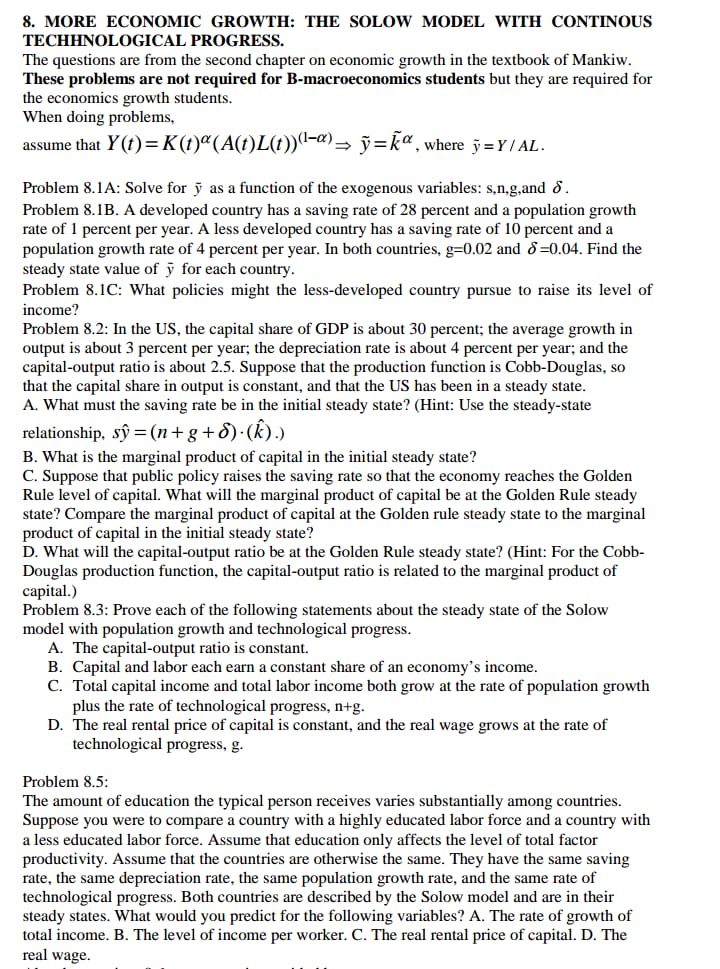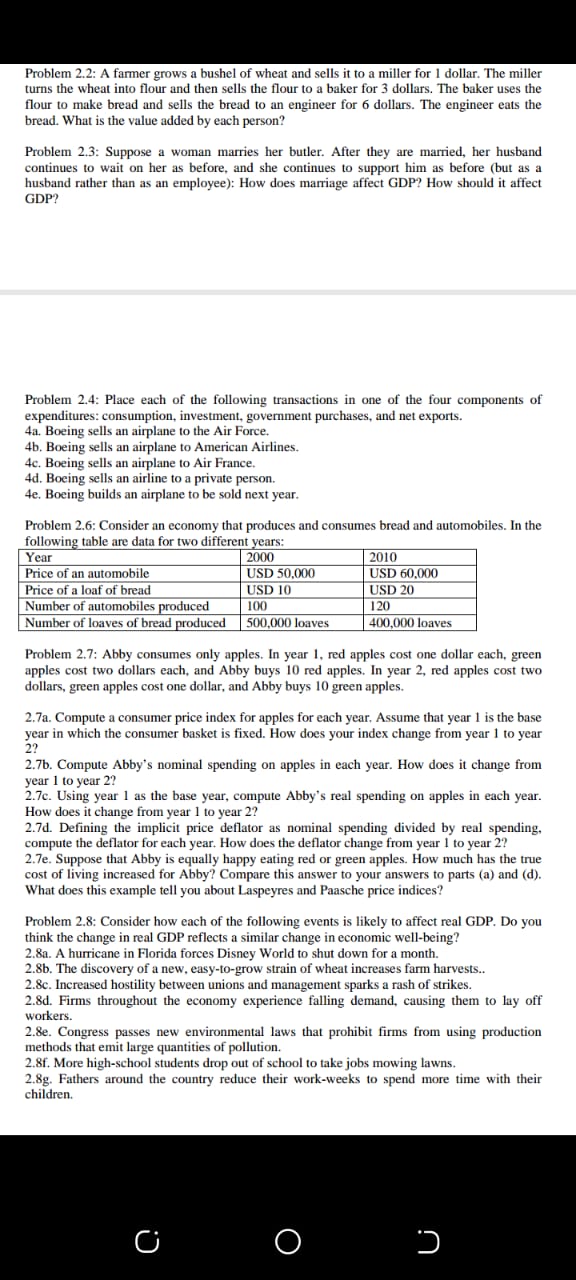8. MORE ECONOltC GROWTH: THE SOLOW MODEL WITH lCONT [NOUS TECHNOLOGICAL PROGRESS. The questions are from the second chapter on economic growth in the textbook of Mankiw. These problems are not required for Enmcruecunumies students but they are required for the economics growth students. When doing problems. assume that Y0\") = K(I)H(A(I)L(I))_al=e )7 =EH. where j. = YIAL. Problem EJA: Solve for jr as a function of the exogenous variables: s.u,g.aud ri' . Problem 8.113. A developed country has a saving rate of 28 percent and a population growth rate of I percent per year. A less developed country has a saving rate of ll] percent and a population growth rate of 4 percent per year. In both countries, g={}.ll2 and 6:034. Find the steady state value of y for each country. Problem 3. 1C: What policies might the less-developed country pursue to raise its level of income? Problem 8.2: In the US. the capital share of GDP is about St] percent; the average growth in output is about 3 percent per year; the depreciation rate is about 4 percent per year; and the capital-output ratio is about 2.5. Suppose that the production function is Cobb-Douglas, so that the capital share in output is constant. and that the US has been in a steady state. A. What must the saving rate he in the initial steady state? (Hint: Use the steady-state relationship. 535 = (I! + g + 5) - HE) J B. What is the marginal product of capital in the initial steady state? C. Suppose that public policy raises the saving rate so that the economy reaches the Golden Rule level of capitaL What will the marginal product of capital be at the Golden Rule steady state? Compare the marginal product of capital at the Golden rule steady state to the marginal product of capital in the initial steady state? D. What will the capital-output ratio be at the Golden Rule steady state? (Hint; For the Cobb- Douglas production function, the capital-output ratio is related to the marginal product of capital.) Problem 83: Prove each of the following statements about the steady state of the Solow model with population growth and technological progress. A. The capital-output ratio is coustanL E. Capital and labor each earn acoustant share of an economy's income. C. Total capital income and total labor income both grow at the rate of population growth plus the rate of technological progress, u+g. D. The real rental price of capital is constant. and me real wage grows at the rate of technological progress. g. Problem 8.5: The amount of education the typical person receives varies substantially among countries. Suppose you were to compare a couutty with a highly educated labor force and a country with a less educated labor force. Assume that education only affects the level of total factor productivity. Assume that the countries are otherwise the same. They have the same saving rate1 the same depreciation rate, the same population growth rate, and the same rate of technological progress. Both countries are described by the Solow model and are in their steady states. What would you predict for the following variables? A. The rate of growth of total income. E. The level of income per worker. C. The real rental price of capital. D. The real wage. Problem 2.2: A farmer grows a bushel of wheat and sells it to a miller for 1 dollar. The miller turns the wheat into flour and then sells the flour to a baker for 3 dollars. The baker uses the flour to make bread and sells the bread to an engineer for 6 dollars. The engineer eats the bread. What is the value added by each person? Problem 2.3: Suppose a woman marries her butler. After they are married, her husband continues to wait on her as before, and she continues to support him as before (but as a husband rather than as an employee): How does marriage affect GDP? How should it affect GDP? Problem 2.4: Place each of the following transactions in one of the four components of expenditures: consumption, investment, government purchases, and net exports. 4a. Boeing sells an airplane to the Air Force. 4b. Boeing sells an airplane to American Airlines. 4c. Boeing sells an airplane to Air France. 4d. Boeing sells an airline to a private person. 4e. Boeing builds an airplane to be sold next year. Problem 2.6: Consider an economy that produces and consumes bread and automobiles. In the following table are data for two different years: Year 2000 2010 Price of an automobile USD 50,000 USD 60,000 Price of a loaf of bread USD 10 USD 20 Number of automobiles produced 100 120 Number of loaves of bread produced 500,000 loaves 400,000 loaves Problem 2.7: Abby consumes only apples. In year 1. red apples cost one dollar each, green apples cost two dollars each, and Abby buys 10 red apples. In year 2, red apples cost two dollars, green apples cost one dollar, and Abby buys 10 green apples. 2.7a. Compute a consumer price index for apples for each year. Assume that year 1 is the base year in which the consumer basket is fixed. How does your index change from year 1 to year 2? 2.7b. Compute Abby's nominal spending on apples in each year. How does it change from year 1 to year 2? 2.7c. Using year 1 as the base year, compute Abby's real spending on apples in each year. How does it change from year I to year 2? 2.7d. Defining the implicit price deflator as nominal spending divided by real spending, compute the deflator for each year. How does the deflator change from year I to year 2? 2.7e. Suppose that Abby is equally happy eating red or green apples. How much has the true cost of living increased for Abby? Compare this answer to your answers to parts (a) and (d). What does this example tell you about Laspeyres and Paasche price indices? Problem 2.8: Consider how each of the following events is likely to affect real GDP. Do you think the change in real GDP reflects a similar change in economic well-being? 2.8a. A hurricane in Florida forces Disney World to shut down for a month. 2.8b. The discovery of a new, easy-to-grow strain of wheat increases farm harvests.. 2.8c. Increased hostility between unions and management sparks a rash of strikes. 2.8d. Firms throughout the economy experience falling demand, causing them to lay off workers. 2.8e. Congress passes new environmental laws that prohibit firms from using production methods that emit large quantities of pollution. 2.8f. More high-school students drop out of school to take jobs mowing lawns. 2.8g. Fathers around the country reduce their work-weeks to spend more time with their children. O O C








